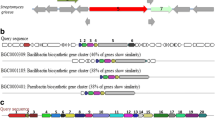Abstract
Acinetobacter indicus strain UBT1 has shown efficient lipase (243 U ml−1) and biosurfactant (61.1% E24% emulsification and surface tension reduction to 37.7 mN m−1) production capabilities using agro-industrial waste as sole carbon source. We report here the draft genome sequence of A. indicus strain UBT1 having genome size of 2.97 Mb with 45.90% GC content. Total 2721 coding genes were predicted using National Center for Biotechnology Information-Prokaryotic Genome Annotation Pipeline (NCBI-PGAP). The whole genome shotgun project sequence data are accessible through NCBI Gene Bank under accession no. JABFOI000000000. PGAP annotation revealed the presence of the triacylglycerol lipase, phospholipase etc., that circuitously confers the oil consumption competency to the strain UBT1. Rapid Annotation using the Subsystem Technology (RAST) server used for mapping the genes to the subsystem resulted in 278 subsystem with 30% subsystem coverage. The draft genome data can be used to exploit the A. indicus strain UBT1 for its advance biotechnological application and also for further comparative genomic studies.




Similar content being viewed by others
Consent for Publication
All authors have given consent for publication.
References
Bento FM, Camargo FA, Okeke BC, Frankenberger W (2005) Comparative bioremediation of soils contaminated with diesel oil by natural attenuation, biostimulation and bioaugmentation. Bioresour Technol 96(9):1049–1055
Patel H, Ray S, Patel A, Patel K, Trivedi U (2020) Enhanced lipase production from organic solvent tolerant Pseudomonas aeruginosa UKHL1 and its application in oily waste-water treatment. Biocatal Agric Biotechnol 28:101731
Snellman EA, Colwell RR (2004) Acinetobacter lipases: molecular biology, biochemical properties and biotechnological potential. J Ind Microbiol Biotechnol 31(9):391–400
Mujumdar S, Joshi P, Karve N (2019) Production, characterization, and applications of bioemulsifiers (BE) and biosurfactants (BS) produced by Acinetobacter spp.: a review. J Basic Microbiol 59(3):277–287
Malhotra J, Anand S, Jindal S, Rajagopal R, Lal R (2012) Acinetobacter indicus sp. nov., isolated from a hexachlorocyclohexane dump site. Int J Syst Evol Microbiol 62(12):2883–2890
Jung J, Baek JH, Park W (2010) Complete genome sequence of the diesel-degrading Acinetobacter sp. strain DR1. J Bacteriol 192(18):4794–4795
Rani M, Weadge JT, Jabaji S (2020) Isolation and characterization of biosurfactant-producing bacteria from well batteries with antimicrobial activities against food-borne and plant pathogens. Front Microbiol 11:64
Salihu A, Alam MZ, AbdulKarim MI, Salleh HM (2019) Lipase production: an insight in the utilization of renewable agricultural residues. Resour Conserv Recycl 58:36–44
Rivera ÁD, Urbina MÁ, y López VE (2019) Advances on research in the use of agro-industrial waste in biosurfactant production. World J Microbiol Biotechnol 35(10):155
Prajapati VS, Ray S, Narayan J, Joshi CG, Patel KC, Trivedi UB, Patel RM (2017) Draft genome sequence of a thermostable, alkaliphilic α-amylase and protease producingBacillus amyloliquefaciens strain KCP2. 3 Biotech 7(6):372
Bolger AM, Lohse M, Usadel B (2014) Trimmomatic: a flexible trimmer for Illumina sequence data. Bioinformatics 30(15):2114–2212
Andrews S (2010) Fastqc—a quality control tool for high throughput sequence data. 08-01-19: Version 0.11.9. http://www.bioinformatics.babraham.ac.uk/projects/fastqc
Tatusova T, DiCuccio M, Badretdin A, Chetvernin V, Nawrocki EP, Zaslavsky L, Lomsadze A, Pruitt KD, Borodovsky M, Ostell J (2016) NCBI prokaryotic genome annotation pipeline. Nucleic Acids Res 44(14):6614–6624
Overbeek R, Olson R, Pusch GD, Olsen GJ, Davis JJ, Disz T, Edwards RA, Gerdes S, Parrello B, Shukla M, Vonstein V (2014) The SEED and the Rapid annotation of microbial genomes using subsystems Technology (RAST). Nucleic Acids Res 42:206–214
Acknowledgements
The support received by the Department of Biosciences as CAS-SAP from UGC, New Delhi, India, is duly acknowledged.
Funding
No funding received for the present research work.
Author information
Authors and Affiliations
Contributions
RP contribute to isolation, microbiological work, methodology, and genome analysis. RS performed isolation and genome analysis. VP was involved in genome analysis, bioinformatics, and formal analysis. KP helped with conceptualization, writing, reviewing, and editing. UT contributed to conceptualization and bioinformatics.
Corresponding author
Ethics declarations
Conflict of interest
The authors declare that there is no conflict of interest regarding the publication of this article.
Ethical Approval
Not applicable.
Additional information
Publisher's Note
Springer Nature remains neutral with regard to jurisdictional claims in published maps and institutional affiliations.
Supplementary Information
Below is the link to the electronic supplementary material.
284_2021_2380_MOESM2_ESM.file
(FILE 3 kb) Cluster assemblies: Cluster of assemblies were generated with removing the redundancy of considered assemblies. Similar assemblies are forming one cluster and have only a single representative chosen based on assembly N50 (Cluster_accessions file lists the cluster name, followed by a tab, followed by a comma-delimited list of the assemblies in that cluster, with the representative assembly marked with a *)
284_2021_2380_MOESM3_ESM.file
(FILE 226 kb) Distance matrix: FastANI produces pairwise ANI measurements of all the generated assemblies’ cluster using only the sequence shared by two assemblies
Rights and permissions
About this article
Cite this article
Patel, R.K., Shah, R.K., Prajapati, V.S. et al. Draft Genome Analysis of Acinetobacter indicus Strain UBT1, an Efficient Lipase and Biosurfactant Producer. Curr Microbiol 78, 1238–1244 (2021). https://doi.org/10.1007/s00284-021-02380-5
Received:
Accepted:
Published:
Issue Date:
DOI: https://doi.org/10.1007/s00284-021-02380-5




